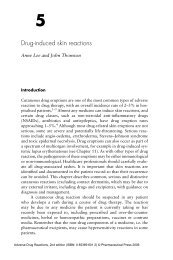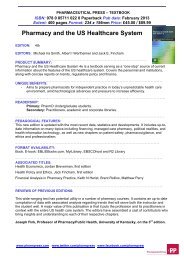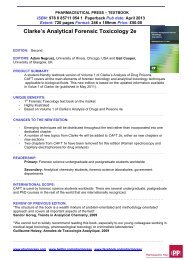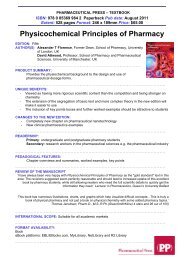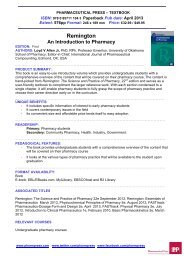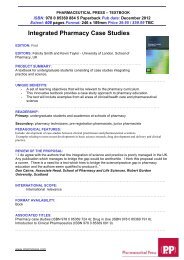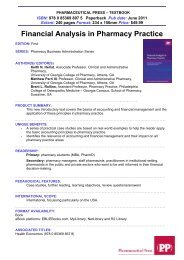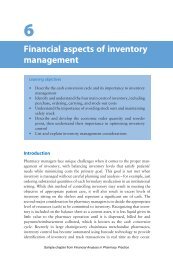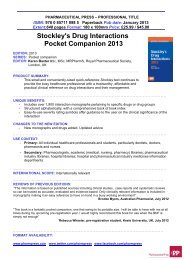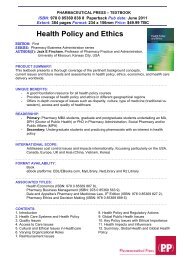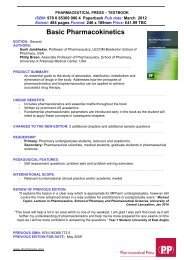6 Extravascular routes of drug administration
6 Extravascular routes of drug administration
6 Extravascular routes of drug administration
You also want an ePaper? Increase the reach of your titles
YUMPU automatically turns print PDFs into web optimized ePapers that Google loves.
106 Basic Pharmacokinetics<br />
6.1 Introduction<br />
Drugs, through dosage forms, are most frequently<br />
administered extravascularly and the majority <strong>of</strong> them<br />
are intended to act systemically; for this reason,<br />
absorption is a prerequisite for pharmacological<br />
effects. Delays or <strong>drug</strong> loss during absorption may<br />
contribute to variability in <strong>drug</strong> response and, occasionally,<br />
may result in a failure <strong>of</strong> <strong>drug</strong> therapy.<br />
The gastrointestinal membrane separates the absorption<br />
site from the blood. Therefore, passage <strong>of</strong><br />
<strong>drug</strong> across the membrane is a prerequisite for absorption.<br />
For this reason, <strong>drug</strong> must be in a solution<br />
form and dissolution becomes very critical for the<br />
absorption <strong>of</strong> a <strong>drug</strong>. The passage <strong>of</strong> <strong>drug</strong> molecules<br />
from the gastrointestinal tract to the general circulation<br />
and factors affecting this are shown in Figs 6.1<br />
and 6.2. Any factor influencing dissolution <strong>of</strong> the<br />
<strong>drug</strong> is likely to affect the absorption <strong>of</strong> a <strong>drug</strong>. These<br />
factors will be discussed, in detail, later in the text.<br />
Drug, once in solution, must pass through membranes<br />
before reaching the general circulation. Hence,<br />
the physicochemical properties <strong>of</strong> the <strong>drug</strong> molecule<br />
(pKa <strong>of</strong> the <strong>drug</strong>, partition coefficient <strong>of</strong> the <strong>drug</strong>, <strong>drug</strong><br />
solubility, etc.), pH at the site <strong>of</strong> <strong>drug</strong> <strong>administration</strong>,<br />
nature <strong>of</strong> the membrane, and physiological factors<br />
will also influence the absorption <strong>of</strong> a <strong>drug</strong>.<br />
The present discussion will deal with general principles<br />
that determine the rate and extent <strong>of</strong> <strong>drug</strong><br />
absorption and the methods used to assess these<br />
and other pharmacokinetic parameters, from plasma<br />
concentration versus time data following oral <strong>administration</strong><br />
<strong>of</strong> <strong>drug</strong>s. Emphasis is placed upon absorption<br />
<strong>of</strong> <strong>drug</strong>s following oral <strong>administration</strong> because it<br />
illustrates all sources <strong>of</strong> variability encountered<br />
during <strong>drug</strong> absorption.<br />
Note that a similar approach may be applied to<br />
determine pharmacokinetic parameters <strong>of</strong> <strong>drug</strong>s when<br />
any other extravascular route is used.<br />
The following assumptions are made.<br />
• Drug exhibits the characteristics <strong>of</strong> onecompartment<br />
model.<br />
• Absorption and elimination <strong>of</strong> a <strong>drug</strong> follow<br />
the first-order process and passive diffusion is<br />
operative all the time.<br />
• Drug is eliminated in unchanged form (i.e., no<br />
metabolism occurs).<br />
• Drug is monitored in the blood.<br />
Useful pharmacokinetic parameters<br />
Figure 6.3 outlines the absorption <strong>of</strong> a <strong>drug</strong> that fits a<br />
one-compartment model with first-order elimination.<br />
The following information is useful:<br />
1 equation for determining the plasma concentration<br />
at any time t<br />
2 determination <strong>of</strong> the elimination half life (t1/2)<br />
and rate constant (K or Kel)<br />
3 determination <strong>of</strong> the absorption half life (t1/2)abs<br />
and absorption rate constant (Ka)<br />
4 lag time (t0), if any<br />
5 determination <strong>of</strong> the apparent volume <strong>of</strong> distribution<br />
(V or Vd) and fraction <strong>of</strong> <strong>drug</strong> absorbed<br />
(F)<br />
6 determination <strong>of</strong> the peak time (tmax)<br />
7 determination <strong>of</strong> the peak plasma or serum concentration<br />
(Cp)max.<br />
6.2 Drug remaining to be<br />
absorbed, or <strong>drug</strong> remaining at<br />
the site <strong>of</strong> <strong>administration</strong><br />
Equation (6.1) describes the changes in mass <strong>of</strong> absorbable<br />
<strong>drug</strong> over time at the site <strong>of</strong> <strong>administration</strong>.<br />
−dXa<br />
dt = Ka(Xa)t (6.1)<br />
where −dX/dt is the decrease in the amount <strong>of</strong> absorbable<br />
<strong>drug</strong> present at the site <strong>of</strong> <strong>administration</strong> per<br />
unit time (e.g., mg h −1 ); Ka is the first-order absorption<br />
rate constant (h −1 ; min −1 ); and (Xa)t is the mass<br />
or amount <strong>of</strong> absorbable <strong>drug</strong> at the site <strong>of</strong> <strong>administration</strong><br />
(e.g., the gastrointestinal tract) at time t.<br />
Upon integration <strong>of</strong> Eq. (6.1), we obtain the following:<br />
(Xa)t = (Xa)t=0e −Kat = FX0e −Kat<br />
Sample chapter for Basic Pharmacokinetics 2nd edition<br />
(6.2)<br />
where (Xa)t=0 is the mass or amount <strong>of</strong> absorbable<br />
<strong>drug</strong> at the site <strong>of</strong> <strong>administration</strong> at time t = 0 (for<br />
extravascular <strong>administration</strong> <strong>of</strong> <strong>drug</strong>, (Xa)t=0 equals<br />
FX0); F is the fraction or percentage <strong>of</strong> the administered<br />
dose that is available to reach the general<br />
circulation; and X0 is the administered dose <strong>of</strong><br />
<strong>drug</strong>.<br />
If F = 1.0, that is, if the <strong>drug</strong> is completely<br />
(100%) absorbed, then<br />
(Xa)t = X0e −Kat . (6.3)



